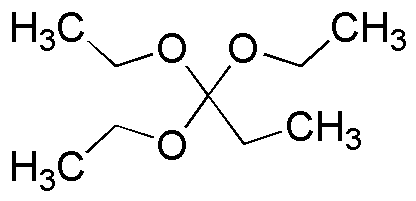Triethyl orthopropionate is widely utilized in research focused on:
- Flavor and Fragrance Industry: This compound serves as a key ingredient in the formulation of various flavors and fragrances, providing a fruity note that enhances products such as perfumes and food flavorings.
- Solvent Applications: It acts as an effective solvent in the production of coatings, inks, and adhesives, offering excellent solvency properties that improve the performance of these materials.
- Synthesis of Esters: Triethyl orthopropionate is used in organic synthesis as a reagent for esterification reactions, allowing chemists to create a wide range of esters for pharmaceuticals and agrochemicals.
- Polymer Production: It plays a role in the production of specialty polymers, contributing to the development of materials with desirable properties for applications in packaging and automotive industries.
- Research and Development: In academic and industrial research, it is utilized as a building block for developing new chemical compounds, enabling advancements in various fields such as materials science and medicinal chemistry.
General Information
Properties
Safety and Regulations
Applications
Triethyl orthopropionate is widely utilized in research focused on:
- Flavor and Fragrance Industry: This compound serves as a key ingredient in the formulation of various flavors and fragrances, providing a fruity note that enhances products such as perfumes and food flavorings.
- Solvent Applications: It acts as an effective solvent in the production of coatings, inks, and adhesives, offering excellent solvency properties that improve the performance of these materials.
- Synthesis of Esters: Triethyl orthopropionate is used in organic synthesis as a reagent for esterification reactions, allowing chemists to create a wide range of esters for pharmaceuticals and agrochemicals.
- Polymer Production: It plays a role in the production of specialty polymers, contributing to the development of materials with desirable properties for applications in packaging and automotive industries.
- Research and Development: In academic and industrial research, it is utilized as a building block for developing new chemical compounds, enabling advancements in various fields such as materials science and medicinal chemistry.
Documents
Safety Data Sheets (SDS)
The SDS provides comprehensive safety information on handling, storage, and disposal of the product.
Product Specification (PS)
The PS provides a comprehensive breakdown of the product’s properties, including chemical composition, physical state, purity, and storage requirements. It also details acceptable quality ranges and the product's intended applications.
Certificates of Analysis (COA)
Search for Certificates of Analysis (COA) by entering the products Lot Number. Lot and Batch Numbers can be found on a product’s label following the words ‘Lot’ or ‘Batch’.
*Catalog Number
*Lot Number
Certificates Of Origin (COO)
This COO confirms the country where the product was manufactured, and also details the materials and components used in it and whether it is derived from natural, synthetic, or other specific sources. This certificate may be required for customs, trade, and regulatory compliance.
*Catalog Number
*Lot Number
Safety Data Sheets (SDS)
The SDS provides comprehensive safety information on handling, storage, and disposal of the product.
DownloadProduct Specification (PS)
The PS provides a comprehensive breakdown of the product’s properties, including chemical composition, physical state, purity, and storage requirements. It also details acceptable quality ranges and the product's intended applications.
DownloadCertificates of Analysis (COA)
Search for Certificates of Analysis (COA) by entering the products Lot Number. Lot and Batch Numbers can be found on a product’s label following the words ‘Lot’ or ‘Batch’.
*Catalog Number
*Lot Number
Certificates Of Origin (COO)
This COO confirms the country where the product was manufactured, and also details the materials and components used in it and whether it is derived from natural, synthetic, or other specific sources. This certificate may be required for customs, trade, and regulatory compliance.


